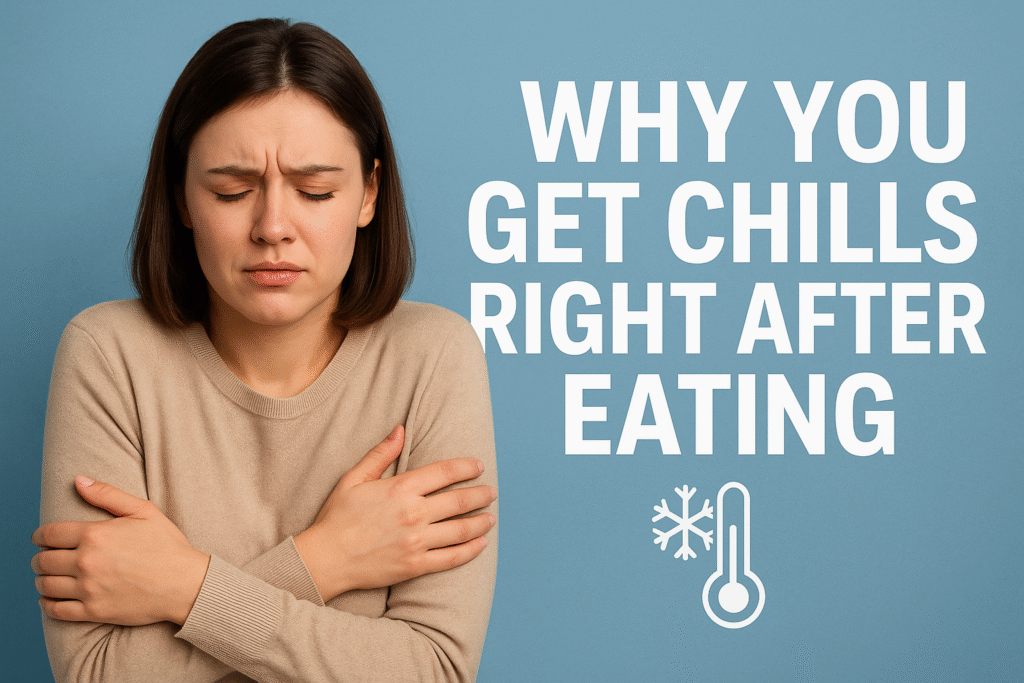
Why You Get Chills Right After Eating: 7 Surprising Causes & Proven Ways to Stop Them
Have you ever finished a meal and suddenly felt a wave of shivers run through your body? Experiencing chills immediately after eating may seem strange, and for many, it can even be a little alarming. While most people associate shivering with cold weather or a fever, post-meal chills are a real physiological phenomenon that affects more people than you might think.
These unexpected shivers are your body’s way of responding to complex processes triggered by digestion, blood sugar shifts, nervous system activity, and sometimes even underlying health conditions. Understanding why this happens can help you distinguish between a harmless quirk of your metabolism and a symptom that warrants medical attention.
In this article, we’ll dive deep into the science behind post-meal chills, explore the common triggers, discuss possible medical causes, and provide practical strategies to prevent or manage these episodes, so you can enjoy your meals without feeling uneasy afterward.
What Does It Mean When You Get Chills After Eating?
Shivering or feeling suddenly cold after a meal is medically referred to as postprandial chills. The term “postprandial” simply means “after eating,” and while it may sound technical, the experience is something many people encounter at some point. These chills are usually short-lived, but they can be accompanied by other symptoms such as sweating, heart palpitations, nausea, lightheadedness or sudden fatigue.
For most people, post-meal chills are harmless, a curious quirk of your body’s digestive and metabolic processes. However, in some cases, they can signal underlying health issues, including blood sugar imbalances, food intolerances, infections or disruptions in the autonomic nervous system. Recognizing the difference between a benign response and a symptom requiring attention is key to understanding your body and maintaining overall health.
The Physiology of Eating: Why Your Body Reacts
Digestion is far more than a simple mechanical process; it’s a finely tuned orchestration of metabolic, vascular, and neurological responses. Each time you eat, your body mobilizes energy, redirects blood flow and triggers hormonal signals, which can sometimes produce unexpected sensations like chills. Let’s break down the main mechanisms behind this phenomenon:
1. Thermic Effect of Food (TEF)
The thermic effect of food refers to the energy your body spends digesting, absorbing, and processing nutrients. Protein-heavy meals, in particular, demand more energy for digestion than carbohydrates or fats, temporarily boosting your metabolism and slightly increasing internal body heat.
In some individuals, this rapid shift in temperature can lead to compensatory shivering, a natural response as the body strives to maintain thermal equilibrium. Essentially, your metabolism “heats up” from digestion and your nervous system responds by triggering tiny, involuntary muscle contractions, what you feel as shivers.
2. Blood Flow Redistribution
After a meal, blood is redirected to the gastrointestinal tract to help with digestion, a process called postprandial hyperemia. While this is a normal and necessary physiological response, it can temporarily reduce blood flow to other areas of the body, particularly the extremities, leading to sensations of coldness or shivering.
Think of it as your body prioritizing digestion: your gut gets the bulk of the circulation, while your hands, feet, or even core may briefly feel a little chilly.
3. Autonomic Nervous System Activation
Your autonomic nervous system (ANS), which regulates involuntary processes such as heart rate, digestion, and body temperature, plays a significant role in post-meal chills. Certain meals especially large, high-fat, or highly spiced ones can stimulate the sympathetic branch of the ANS, often referred to as the “fight-or-flight” system.
This activation can trigger:
- Shivering or chills
- Sweating
- Rapid heartbeat or palpitations
- Heightened alertness or anxiety
In essence, your body reacts to the physical stress of digestion as if it’s preparing for action, even though you’re just sitting down to eat.
Common Causes of Post-Meal Chills
Several factors, ranging from normal physiological responses to medical conditions can cause chills after eating. Understanding these triggers can help you identify whether your episodes are benign or something that warrants a closer look.
1. Hypoglycemia (Low Blood Sugar)
One of the most frequent causes of post-meal chills is low blood sugar. After eating, particularly meals high in sugar or refined carbohydrates, your body may release a surge of insulin to manage rising glucose levels. In some individuals, this insulin spike overshoots, causing blood sugar to drop too quickly, a phenomenon called reactive hypoglycemia.
Symptoms of reactive hypoglycemia may include:
- Shivering or chills
- Sweating
- Anxiety or irritability
- Fatigue or weakness
- Rapid heartbeat
Preventing blood sugar swings can reduce the likelihood of post-meal chills. Include protein, healthy fats, and fiber in your meals to slow digestion and maintain more stable blood sugar levels.
2. Food Intolerance or Allergic Reactions
Even mild food intolerances or allergies can trigger post-meal chills, often due to the release of histamines or other immune responses. Common triggers include:
- Dairy (lactose intolerance)
- Gluten (celiac disease or sensitivity)
- Shellfish, nuts, or other allergens
Symptoms may range from mild to severe and can include:
- Chills or shivering
- Flushing or skin redness
- Gastrointestinal distress (bloating, cramps, diarrhea)
- In extreme cases, anaphylaxis, which is a medical emergency
It’s worth noting that even foods you tolerate well most of the time can occasionally trigger a reaction if your body is under stress, fatigued, or fighting an infection.
3. Infections or Fever
Sometimes, post-meal chills can be a sign that your body is fighting an infection. When your immune system is activated, your metabolism and energy usage change, and even routine digestion can temporarily exacerbate symptoms. Because digesting food requires energy, your body may respond with:
- Shivering or post-meal chills
- Sweating
- Feeling cold even in a warm environment
Common infections that can trigger these reactions include:
- Gastrointestinal infections, such as food poisoning, which can cause systemic inflammation and temperature fluctuations.
- Viral infections, like the flu or a common cold, which can heighten sensitivity to temperature changes.
In these cases, chills are usually accompanied by other signs of infection, such as fever, body aches, fatigue, or nausea.
4. Autonomic Nervous System Disorders
Disorders affecting the autonomic nervous system (ANS) can cause unusual bodily responses after eating. Conditions such as postural orthostatic tachycardia syndrome (POTS) or dysautonomia disrupt the normal regulation of heart rate, blood pressure, and temperature.
After meals, this dysregulation can lead to:
- Shivering or chills
- Rapid heartbeat or palpitations
- Lightheadedness or dizziness
- Excessive sweating
For people with ANS disorders, even small meals can trigger exaggerated physiological responses, making postprandial chills a frequent occurrence.
5. Spicy Foods or High-Caffeine Meals
Certain foods can directly stimulate your nervous system or raise your internal temperature.
- Spicy foods contain capsaicin, which temporarily increases body temperature. This can trigger shivering as your body attempts to maintain a stable thermal balance.
- Caffeine or energy drinks stimulate the nervous system and may induce palpitations, jitteriness, or chills, especially if consumed in large amounts or on an empty stomach.
These reactions are usually harmless but can be uncomfortable if they happen frequently.
6. Large Meals or High-Fat Meals
Overeating or consuming meals very high in fat can slow down digestion and place extra demands on your metabolic and circulatory systems. This increased strain can activate the sympathetic nervous system, sometimes resulting in post-meal chills. Factors such as dehydration, stress, or rapid eating can make these symptoms more pronounced.
7. Thyroid Dysfunction
An underactive thyroid (hypothyroidism) reduces your body’s metabolic rate, making it harder to maintain warmth. People with thyroid issues may experience:
- Postprandial chills
- Fatigue and sluggishness
- Weight gain
- Increased sensitivity to cold
If you frequently feel chilled after meals along with other thyroid-related symptoms, a medical evaluation may be necessary.
Other Less Common Causes
While rare, the following conditions can also contribute to chills after eating:
- Diabetes-related autonomic neuropathy, which impairs the body’s ability to regulate blood sugar and temperature.
- Sepsis or systemic infection, which can cause extreme temperature swings.
- Medication side effects, such as insulin, beta-blockers, or certain antidepressants.
- Anemia or low iron levels, which reduce oxygen delivery to tissues, leaving you feeling cold.
When to See a Doctor
Most post-meal chills are harmless and transient. However, you should seek medical attention if you notice:
- Frequent or severe chills after every meal
- Dizziness, fainting, or lightheadedness
- Rapid heartbeat, palpitations, or shortness of breath
- Nausea, vomiting, or diarrhea
- Unexplained weight loss or persistent fatigue
- Signs of an allergic reaction, such as swelling, hives or difficulty breathing
A healthcare professional can evaluate your symptoms, run appropriate tests, and identify any underlying medical issues that may require treatment. Early detection can prevent complications and help you manage symptoms more effectively.
Diagnosing the Cause of Post-Meal Chills
When post-meal chills are frequent, severe, or accompanied by other symptoms, it’s important to identify the underlying cause. Healthcare providers often use a combination of approaches:
1. Physical Examination
During an exam, your doctor may look for:
- Signs of fever or infection, such as elevated temperature or localized tenderness
- Blood pressure and heart rate changes, which may indicate autonomic nervous system involvement
- Signs of thyroid dysfunction, including slowed reflexes, dry skin, or swelling
A careful physical exam can provide valuable clues about whether your post-meal chills are benign or linked to a medical condition.
2. Blood Tests
Laboratory tests can help identify systemic or metabolic issues that contribute to chills:
- Blood glucose levels (fasting and postprandial) to check for reactive hypoglycemia
- Thyroid function tests (TSH, T3, T4) to assess for hypo- or hyperthyroidism
- Complete blood count (CBC) to detect infections, anemia, or other blood-related problems
3. Imaging
If gastrointestinal or structural issues are suspected, your doctor may order imaging tests such as:
- Abdominal ultrasound to detect liver, gallbladder, or pancreatic abnormalities
- CT scan for more detailed structural imaging
- Endoscopy to evaluate the digestive tract for inflammation, ulcers, or other issues
4. Food and Symptom Tracking
Keeping a detailed food and symptom diary can be invaluable for identifying triggers. Record:
- Meal composition (protein, fats, carbohydrates)
- Timing of chills and other symptoms
- Environmental or lifestyle factors, such as stress or temperature changes
Tracking patterns over time can help you and your healthcare provider pinpoint dietary or lifestyle factors contributing to postprandial chills.
Managing and Preventing Post-Meal Chills
Even if post-meal chills are generally harmless, there are practical steps you can take to reduce their frequency and intensity. Adopting these strategies can help your body maintain balance after eating and make mealtimes more comfortable.
1. Eat a Balanced Diet
A well-rounded diet is key to preventing postprandial chills. Include a mix of:
- Complex carbohydrates such as whole grains, vegetables, and legumes, which release glucose slowly and prevent sudden spikes and crashes.
- Proteins from lean meats, fish, eggs, or plant-based sources, which support sustained energy.
- Healthy fats like avocados, nuts, seeds, and olive oil, which aid in digestion and stabilize blood sugar.
Avoid excessive consumption of sugar and refined carbohydrates, as these can trigger rapid fluctuations in blood glucose, leading to shivering or lightheadedness after eating.
2. Opt for Smaller, Frequent Meals
Eating smaller portions more frequently throughout the day helps your body digest food efficiently while preventing large swings in blood sugar. Large, heavy meals can overload the digestive system, increase sympathetic nervous system activation, and sometimes trigger chills. Dividing your daily intake into 4-5 moderate meals can reduce metabolic stress and promote steady energy levels.
3. Stay Hydrated
Proper hydration is essential for digestion, circulation, and body temperature regulation. Drinking water throughout the day and during meals can help your body manage heat distribution and reduce the likelihood of feeling cold or shivery after eating. Herbal teas or warm water can provide additional comfort, particularly in colder environments.
4. Identify and Avoid Trigger Foods
Certain foods can provoke post-meal chills, particularly if your body is sensitive or intolerant to them. Common triggers include:
- Spicy meals, which can stimulate thermogenesis and nervous system activity, sometimes leading to shivering.
- High-caffeine beverages, which may overstimulate your heart and nervous system.
- Foods linked to allergies or intolerances, such as dairy, gluten, shellfish, or nuts.
Tracking your meals and symptoms can help you identify specific triggers and make adjustments accordingly.
5. Monitor Blood Sugar Levels
If you suspect reactive hypoglycemia, keeping track of your blood glucose can provide valuable insights. Regular monitoring, combined with dietary adjustments and guidance from a healthcare professional, can help prevent sudden drops in blood sugar that may cause chills, palpitations, or fatigue after meals.
6. Manage Stress and Support the Nervous System
Stress can amplify the body’s autonomic responses, making post-meal chills more likely or severe. Incorporating stress-management techniques can help calm the nervous system and improve your body’s ability to handle digestion. Effective practices include:
- Deep breathing exercises
- Yoga or gentle stretching
- Meditation or mindfulness sessions
- Short walks or light activity to relax both body and mind
Natural Remedies for Post-Meal Chills
For mild or occasional episodes, simple home remedies can help ease discomfort:
- Warm drinks: Sipping herbal tea or warm water can stabilize body temperature and provide soothing comfort.
- Light movement: Gentle walking after meals encourages blood circulation and supports digestion, reducing feelings of shivering.
- Layered clothing: Wearing warm layers post-meal can counteract temporary drops in body temperature, especially if you tend to feel cold easily.
Combined with a balanced diet, proper hydration, and stress management, these strategies are often sufficient to manage postprandial chills without medical intervention.
Key Takeaways
- Post-meal chills are often harmless, but they can sometimes signal underlying issues such as reactive hypoglycemia, food intolerances, infections or autonomic nervous system dysfunction.
- Symptoms are usually short-lived, but may include shivering, sweating, palpitations, nausea, fatigue or lightheadedness.
- Preventive measures such as eating balanced meals, consuming smaller, frequent portions, staying well-hydrated, and managing stress can help reduce or prevent episodes.
- Seek medical attention if post-meal chills are frequent, severe, or accompanied by concerning symptoms such as dizziness, fainting, rapid heartbeat, unexplained weight loss, or signs of an allergic reaction.
By understanding the potential triggers and practicing simple preventive strategies, most people can manage post-meal chills effectively and maintain comfort after eating.
👩⚕️ Need Personalized Health Advice?
Get expert guidance tailored to your unique health concerns through MuseCare Consult. Our licensed doctors are here to help you understand your symptoms, medications, and lab results—confidentially and affordably.
👉 Book a MuseCare Consult NowConclusion
Experiencing chills after eating can be surprising or even unsettling, but for most people, it is a temporary and manageable response. These shivers are often the body’s natural way of adjusting to digestion, blood sugar changes, or nervous system activation. By understanding the potential triggers, ranging from blood sugar fluctuations and food intolerances to large meals or autonomic nervous system responses, you gain the insight needed to take practical steps that reduce or prevent these episodes.
Simple lifestyle adjustments can make a noticeable difference. Eating balanced meals with the right combination of proteins, healthy fats, and complex carbohydrates helps stabilize your metabolism. Choosing smaller, more frequent meals can prevent sudden blood sugar spikes or crashes. Staying hydrated supports circulation and digestion, while stress management techniques such as deep breathing, meditation, or gentle exercise can calm the nervous system and reduce post-meal shivering.
However, not all post-meal chills are harmless. If they become frequent, severe, or occur alongside other concerning symptoms such as dizziness, palpitations, nausea, unexplained weight loss, or signs of an allergic reaction, it’s important to consult a healthcare professional. Early evaluation ensures that any underlying conditions are identified and addressed promptly, providing both relief and peace of mind, with awareness, preventive strategies, and consistent lifestyle adjustments, most people can minimize postprandial chills and regain confidence in their body’s response to food. Understanding these mechanisms empowers you to enjoy your meals comfortably, without the discomfort or worry of unexpected shivering, allowing mealtimes to remain a pleasant and nourishing part of your day.
⚠️ Affiliate Disclaimer: This post may contain affiliate links, which means I may earn a small commission — at no extra cost to you — if you make a purchase through one of these links. I only recommend products or services I genuinely trust and believe can provide value. Thank you for supporting My Medical Muse!
Recommended Post:
- 7 Powerful Reasons Why You Are Craving Salt and What Your Body Is Trying To Tell You
- 7 Fascinating Reasons Why You Shiver When You’re Not Cold
- 13 Surprising Reasons Why Your Body Feels Cold Even in a Warm Room
- 7 Surprising Reasons Why Your Body Temperature Keeps Changing Randomly
- 7 Fascinating Reasons Why You Get Goosebumps Randomly Throughout the Day


